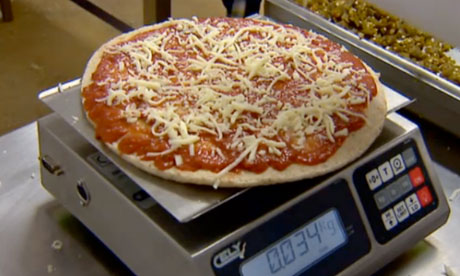
If you're anything like me, a healthy pizza means closing your ears to the siren call of the calzone, saying arrivederci to all that oozes mozzarella and drips grease, and opting for the spartan napoletana instead – on a fashionably thin base, naturally. (Deep pans are so very 1980s – as well as boasting a third more calories.)
But, it turns out, this sacrifice isn't enough. Glasgow University Chair of Human Nutrition Professor Mike Lean (nominative determinism at work) has been working with a company called Eat Balanced to produce what they claim are "the only nutritionally balanced pizzas you can buy" – although actually you can't, at the moment anyway. They're currently in negotiation with a major supermarket chain interested in stocking their worthy wares. Founder Donnie Maclean – another man surely born to be slim – won't divulge the name, but assures me it's "one of the big four".
Surprisingly, there's not a depressingly beige wholemeal crust or a vegetable medley in sight: the launch range is reassuringly unimaginative: cheese and tomato, spicy chicken with peppers and jalapeños, and, my own personal nostalgic favourite, ham and pineapple. This is a deliberate choice, Donnie explains; "we wanted to make the first three as generic as possible so people wouldn't be scared off ... but we've got some more inventive ideas."
But all is not what it seems, because the trad toppings – "all natural!" – hide a base flecked "like black pepper" with Hebridean seaweed. This, apparently, acts as a low-sodium seasoning, as well as supplying iron, iodine, and vitamin B12 so, although the pizzas fall well below government salt targets, "they don't taste like they need salt". The tomato sauce, meanwhile, is made with red pepper, which boosts its vitamin C content. Each pizza, the company proudly claims, provides a third of your daily nutrition requirements, from fibre to fat and protein.
Of course, if we hadn't fiddled about with pizza in the first place, we wouldn't have needed to turn to seaweed for help. The pizza is just another Mediterranean flatbread, and the Oxford Companion to Food reckons it's "safe to assume that since early classical times people ... were at least sometimes" adding toppings. I think it's also safe to assume, however, that they weren't loading on the extra pepperoni and double mozzarella which led to Dominos' Pepperoni Passion pizza landing the coveted bottom spot in a 2011 Which? survey of pizza nutrition. Obviously, as all true pizza aficionados will know, this was before the fateful launch of Pizza Hut's hot dog stuffed crust in April.
Although we don't know what the Romans might have put on their pizza, we do know that the traditional pizzas of Naples, whose far-flung sons and daughters put the dish on the world map, were topped with little more than olive oil, tomatoes, garlic and oregano. Mozzarella and basil were added to celebrate the visit of Queen Margherita to the city in 1889 – so we may well be able to blame her for all subsequent degradations.
Indeed, even tomatoes might be considered too much by some: pizza bianca is often topped with nothing but olive oil and herbs, which puts the 30", 11lb carnivore challenge pizza which defeated Adam Richman in the first series of Man v Food into perspective.
Those prone to celebrity influence might be interested to learn that the great Armando Iannucci apparently prefers his without cheese – and, as the son of a Neapolitan who set up what he's described as a "Heath Robinson-type pizza factory" in the tenements of Glasgow, he should know his stuff.
Scotland, of course, shoulders the responsibility for the deep-fried battered pizza, among other culinary crimes (although there's no suggestion that Iannucci senior was involved) so perhaps this seaweed concoction is their attempt to make amends. That said, the only place I've ever seen a pizza topped with chips is Bergamo, so Italians can't afford to get too snotty either.
Eat Balanced have also developed a nutritionally balanced curry – a "gap in the market" that might come as some surprise to India's many millions of vegetarians – which should hit shelves next year, although reports of a healthy fish and chips in the pipeline are, Donnie tells me, much exaggerated.
Would you be tempted to try these nutritionally-balanced pizzas – or would you prefer to save the pepperoni, prosciutto and parmesan for an occasional pig out? Do you make your own healthy pizzas at home, and if so, what do you put on them? And what's the worst topping you've ever seen abusing the good name of pizza?

